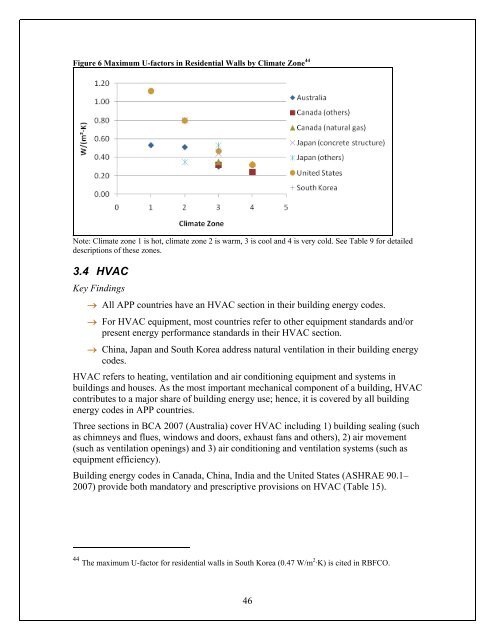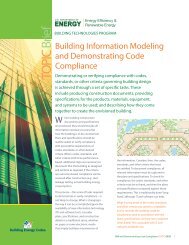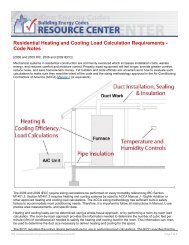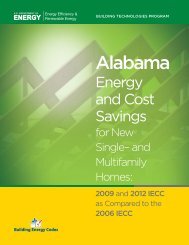Shaping the Energy Efficiency in New Buildings - Building Energy ...
Shaping the Energy Efficiency in New Buildings - Building Energy ...
Shaping the Energy Efficiency in New Buildings - Building Energy ...
Create successful ePaper yourself
Turn your PDF publications into a flip-book with our unique Google optimized e-Paper software.
Figure 6 Maximum U-factors <strong>in</strong> Residential Walls by Climate Zone 44Note: Climate zone 1 is hot, climate zone 2 is warm, 3 is cool and 4 is very cold. See Table 9 for detaileddescriptions of <strong>the</strong>se zones.3.4 HVACKey F<strong>in</strong>d<strong>in</strong>gs All APP countries have an HVAC section <strong>in</strong> <strong>the</strong>ir build<strong>in</strong>g energy codes. For HVAC equipment, most countries refer to o<strong>the</strong>r equipment standards and/orpresent energy performance standards <strong>in</strong> <strong>the</strong>ir HVAC section. Ch<strong>in</strong>a, Japan and South Korea address natural ventilation <strong>in</strong> <strong>the</strong>ir build<strong>in</strong>g energycodes.HVAC refers to heat<strong>in</strong>g, ventilation and air condition<strong>in</strong>g equipment and systems <strong>in</strong>build<strong>in</strong>gs and houses. As <strong>the</strong> most important mechanical component of a build<strong>in</strong>g, HVACcontributes to a major share of build<strong>in</strong>g energy use; hence, it is covered by all build<strong>in</strong>genergy codes <strong>in</strong> APP countries.Three sections <strong>in</strong> BCA 2007 (Australia) cover HVAC <strong>in</strong>clud<strong>in</strong>g 1) build<strong>in</strong>g seal<strong>in</strong>g (suchas chimneys and flues, w<strong>in</strong>dows and doors, exhaust fans and o<strong>the</strong>rs), 2) air movement(such as ventilation open<strong>in</strong>gs) and 3) air condition<strong>in</strong>g and ventilation systems (such asequipment efficiency).Build<strong>in</strong>g energy codes <strong>in</strong> Canada, Ch<strong>in</strong>a, India and <strong>the</strong> United States (ASHRAE 90.1–2007) provide both mandatory and prescriptive provisions on HVAC (Table 15).44 The maximum U-factor for residential walls <strong>in</strong> South Korea (0.47 W/m2·K) is cited <strong>in</strong> RBFCO.46
















